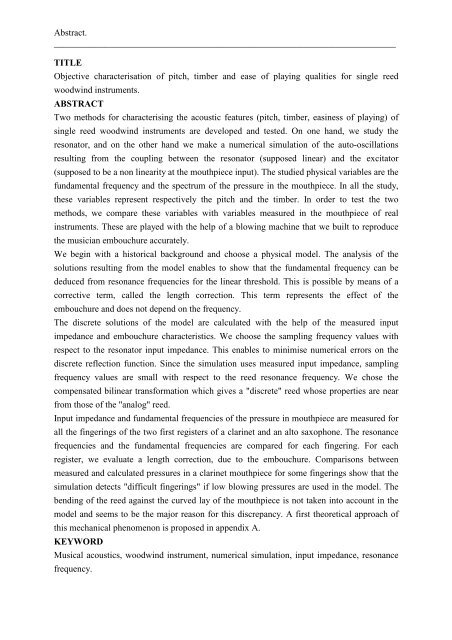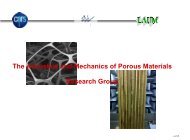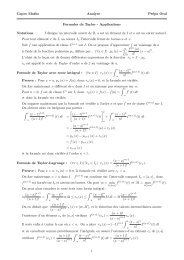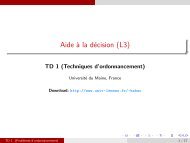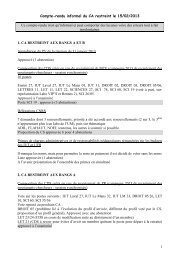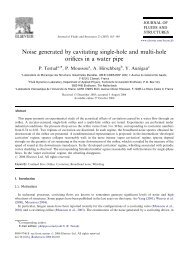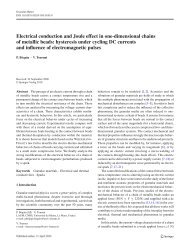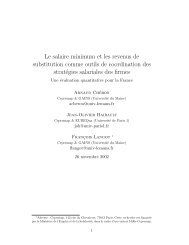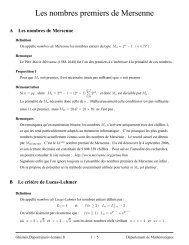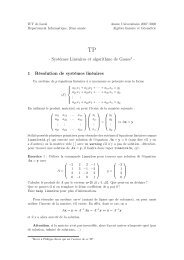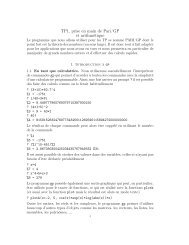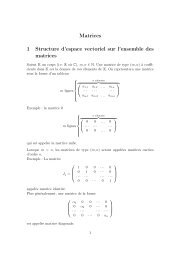Caractérisation objective de la qualité de justesse, de timbre et d ...
Caractérisation objective de la qualité de justesse, de timbre et d ...
Caractérisation objective de la qualité de justesse, de timbre et d ...
- No tags were found...
You also want an ePaper? Increase the reach of your titles
YUMPU automatically turns print PDFs into web optimized ePapers that Google loves.
Abstract.___________________________________________________________________________TITLEObjective characterisation of pitch, timber and ease of p<strong>la</strong>ying qualities for single reedwoodwind instruments.ABSTRACTTwo m<strong>et</strong>hods for characterising the acoustic features (pitch, timber, easiness of p<strong>la</strong>ying) ofsingle reed woodwind instruments are <strong>de</strong>veloped and tested. On one hand, we study theresonator, and on the other hand we make a numerical simu<strong>la</strong>tion of the auto-oscil<strong>la</strong>tionsresulting from the coupling b<strong>et</strong>ween the resonator (supposed linear) and the excitator(supposed to be a non linearity at the mouthpiece input). The studied physical variables are thefundamental frequency and the spectrum of the pressure in the mouthpiece. In all the study,these variables represent respectively the pitch and the timber. In or<strong>de</strong>r to test the twom<strong>et</strong>hods, we compare these variables with variables measured in the mouthpiece of realinstruments. These are p<strong>la</strong>yed with the help of a blowing machine that we built to reproduc<strong>et</strong>he musician embouchure accurately.We begin with a historical background and choose a physical mo<strong>de</strong>l. The analysis of thesolutions resulting from the mo<strong>de</strong>l enables to show that the fundamental frequency can be<strong>de</strong>duced from resonance frequencies for the linear threshold. This is possible by means of acorrective term, called the length correction. This term represents the effect of theembouchure and does not <strong>de</strong>pend on the frequency.The discr<strong>et</strong>e solutions of the mo<strong>de</strong>l are calcu<strong>la</strong>ted with the help of the measured inputimpedance and embouchure characteristics. We choose the sampling frequency values withrespect to the resonator input impedance. This enables to minimise numerical errors on thediscr<strong>et</strong>e reflection function. Since the simu<strong>la</strong>tion uses measured input impedance, samplingfrequency values are small with respect to the reed resonance frequency. We chose thecompensated bilinear transformation which gives a "discr<strong>et</strong>e" reed whose properties are nearfrom those of the "analog" reed.Input impedance and fundamental frequencies of the pressure in mouthpiece are measured forall the fingerings of the two first registers of a c<strong>la</strong>rin<strong>et</strong> and an alto saxophone. The resonancefrequencies and the fundamental frequencies are compared for each fingering. For eachregister, we evaluate a length correction, due to the embouchure. Comparisons b<strong>et</strong>weenmeasured and calcu<strong>la</strong>ted pressures in a c<strong>la</strong>rin<strong>et</strong> mouthpiece for some fingerings show that thesimu<strong>la</strong>tion <strong>de</strong>tects "difficult fingerings" if low blowing pressures are used in the mo<strong>de</strong>l. Thebending of the reed against the curved <strong>la</strong>y of the mouthpiece is not taken into account in themo<strong>de</strong>l and seems to be the major reason for this discrepancy. A first theor<strong>et</strong>ical approach ofthis mechanical phenomenon is proposed in appendix A.KEYWORDMusical acoustics, woodwind instrument, numerical simu<strong>la</strong>tion, input impedance, resonancefrequency.


